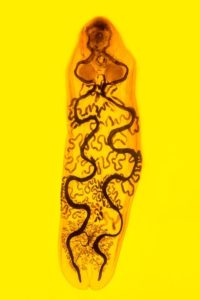From the Micrarium: Isoparorchis, a parasite of an Australian catfish species locally endangered in the Murray-Darling Basin.
By ucwehlc, on 22 May 2023
Even though the Grant Museum is closed this summer, we still have plenty of exciting stories to tell from the collection!
Today’s blog is by visiting researcher Dr Andrew McCarthy from Canterbury College, UK.
The Micrarium at the Grant Museum of Zoology is a beautiful and unique display of illuminated glass microscope slides of specimens from a bewildering range of groups within the Animal Kingdom. Each slide has its own story and potentially its own contribution to make to the study of zoology. The specimen on one such slide is probably at present better known than the rest due to its appearance in Jack Ashby’s excellent book “Animal Kingdom: A Natural History in 100 Objects” based on specimens from the Grant Museum. The specimen of a trematode parasite in the genus Isoparorchis appears in the book as a photogenic example of a parasitic flatworm in a concise overview of the group.

The Parasite: Isoparorchis specimen from the Micrarium
© UCL Grant Museum of Zoology & Oliver Siddons
As a parasitologist and visiting researcher I was interested to learn more about this animal and, if possible, to further our knowledge of its specific identity. Isoparorchis is a genus of hemiuroid flukes known to be parasites of the air (swim) bladder in freshwater catfishes (Osteichthyes: Silriformes) in Asia and Australia. The microscope slide on which the specimen is mounted is labelled “Isoparorchis?” and “Australia”. The specimen is certainly of the genus Isoparorchis and if its origin is Australia then its likely specific identification becomes a little easier, as does the probable identity of its host. There is at present only one species of the genus recorded from Australia, this being Isoparorchis tandani, a species ultimately described from the Eel Tail Catfish (Tandanus tandanus) by Thomas Harvey Johnston, Professor of Zoology at the University of Adelaide, in 1927. The specimens on which his description was based were collected from river systems in Queensland, Australia, including the Murray-Darling System.
From examination of the specimen there is nothing to suggest that the Grant Museum specimen is not Isoparorchis tandani (Johnston, 1927), and it appears to have the main diagnostic feature of this species in that the testes appear to be larger than the diameter of the ventral sucker. Like many digenean parasites I. tandani has a complex life cycle involving developmental stages in different animal hosts. The adult stage is found in the catfish, but the life cycle also involves a freshwater prosobranch snail as first intermediate host and atyid shrimps as second intermediate hosts. It is thought that the catfish definitive host acquires infection by eating infected shrimps.

The Murray-Darling River System, Australia
(via Creative Commons Attribution-Share Alike 4.0 International)
Unfortunately, the host of I.tandani, the Eel Tail Catfish is now endangered within the Murray-Darling Basin for reasons including habitat loss including destruction of breeding sites through siltation, competitive and predatory interactions with introduced fish species (eg. Redfin Perch Perca fluviatilis), run-off of chemical pollution including agricultural pesticides, and overfishing. It is therefore likely that I. tandani will be under threat of extinction together with its host. This is sadly the current situation facing several parasite and commensal species throughout the World in what has become known as the Sixth Mass Co-Extinction, accompanying the ongoing Sixth Mass Extinction of species in general on our planet; this being the only major extinction known to have been caused by the actions of humans.
So, Isoparorchis from the Grant Museum collection may assume a new importance in the future, evidencing part of the parasite diversity of a fragile host species possibly, although hopefully not probably, lost to the extinction vortex.
 Close
Close


